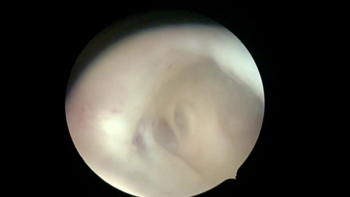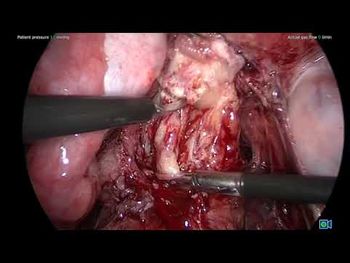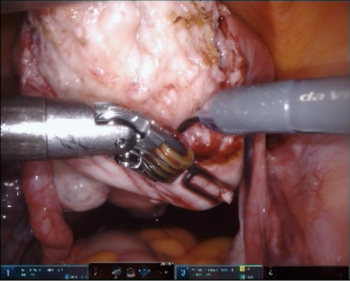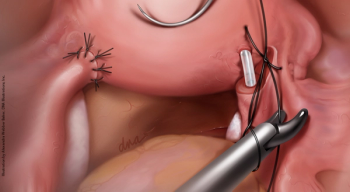
A new randomized trial compared the failure rates of vaginal mesh against hysterectomy with uterosacral ligament suspension for prolapse surgery.

A new randomized trial compared the failure rates of vaginal mesh against hysterectomy with uterosacral ligament suspension for prolapse surgery.

From a USPSTF update on BRCA1/2 screening to a vaginal ring that has shown effectiveness towards preventing HIV, these are five of the most noteworthy gynecologic-focused studies published In August 2019.

Surgical wound classification is an important predictor of postoperative surgical site infections and this will ensure that correct classification is recorded

Rates of revision surgery for mesh midurethral sling placement drop dramatically once a surgeon has reached a certain threshold of annual cases, according to results of a new study.

Minimizing intrauterine trauma is the key to prevention of adhesions, but treatment is possible when they occur.

Ilana Cass, MD, discusses why ob/gyns should talk with their patients about salpingectomy, as well as where to focus future research.

Tips to provide better care for patients and improve the value of the healthcare dollar.

Six services within the realm of minimally invasive gynecologic surgery (MIGS) can easily and inexpensively be incorporated into an ob/gyn practice, according to a panel discussion at the 2019 American College of Obstetricians and Gynecologists annual clinical and scientific meeting in Nashville.

What’s your diagnosis in a patient with lesions that are sometimes painful and do not respond to antibiotics?

Nisse V. Clark, MD, Renita Kim, MD, MPH, and Jon Einarsson, MD, PhD, MPH show how they treat multifocal bowel endometriosis in a 25-year-old G0 with dysmenorrhea, dyschezia, and cyclic rectal bleeding.

A relatively new laparoscopic technique, which entails use of the pelvic peritoneum to increase vaginal length, may be an effective treatment for dyspareunia.

While minimally invasive and open surgeries have been found to produce similar survival rates in other early cancers, that might not be the case for early cervical cancer. PLUS: At what age should cervical cancer screening stop? ALSO: How much do genetic variants affect breast cancer risk?

Rates of post-hysterectomy infection have been shown to be lower in hospitals that have adopted evidence-based guidelines for preventing postsurgical infections.

Bowel injuries are not often recognized at surgery so communication with the patient following surgery is vital.

Jon I. Einarsson, MD, PhD, MPH, and Nisse V. Clark, MD, discuss their novel technique for Essure reversal in this video.

With the impending withdrawal of Essure from the US market, ob/gyns should know how to remove the device. The authors describe the traditional technique and their new approach.

Use of simulation technology for training on labor and delivery is increasing and studies show it can help reduce complications such as perineal lacerations and brachial plexus injury.

Innovation is a major component of gynecologic surgery and surgeons at all levels play a role in progressing the specialty

An ob/gyn shares her experience with implementing enhanced recovery after surgery (ERAS) and its effect on patient care at her institution

Results of a recent extended study of prolapse surgery showed that in 60% of women, two common procedures failed within 5 years, but patients still reported a higher quality of life than before the surgery. Plus: ACOG has released a revised Committee Opinion to emphasize the idea of the “fourth trimester” in an attempt to reduce maternal morbidity and mortality numbers. Also: A recent study suggests that entering menopause later in life may be associated with a small boost in memory performance years later.

A woman sues after a surgical needle was accidentally left in the patient during a vaginal prolapse surgery. Plus more cases.

Recent studies suggest that a progestin-induced withdrawal bleed may reduce conception and live birth rates in women undergoing ovulation induction with clomiphene citrate.

Total vaginal hysterectomy was found to be associated with better postoperative clinical outcomes and lower hospital costs compared to either total abdominal or robotic laparoscopic hysterectomy, according to the results of a retrospective study presented at the 46th AAGL Global Congress on Minimally Invasive Gynecology.

When it comes to robotic surgical dexterity, gynecologic oncology ranks higher than other disciplines, according to the results of a crowd-sourced assessment of technical skills presented at the 46th AAGL Global Congress on Minimally Invasive Gynecology.

While most clinicians remove vaginal mesh through the vagina, employing laparoscopy is feasible and safe, especially when there is limited visualization through the vagina, according to a case series presented at the 46th AAGL Global Congress on Minimally Invasive Gynecology.